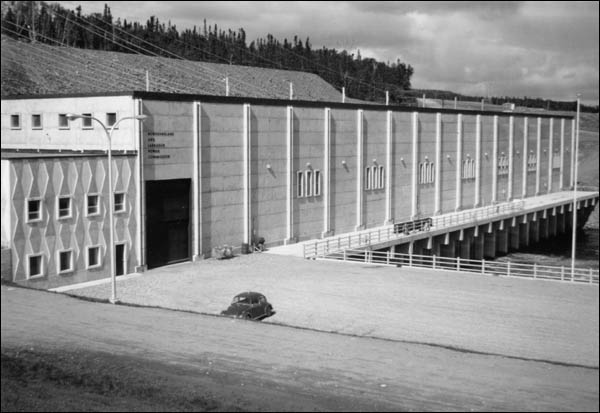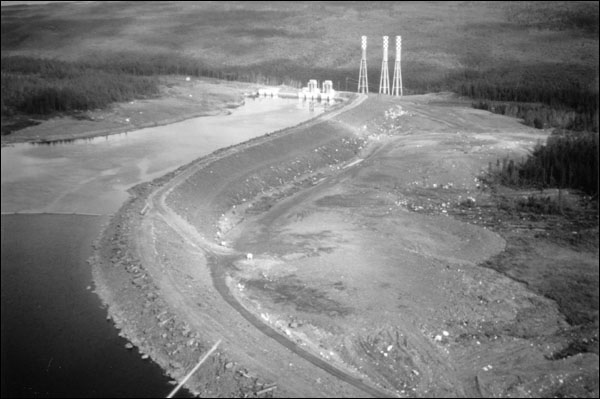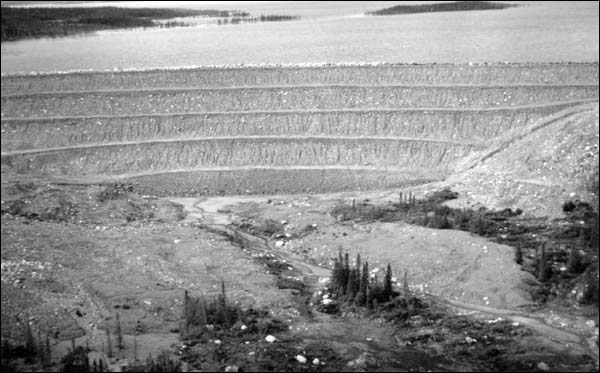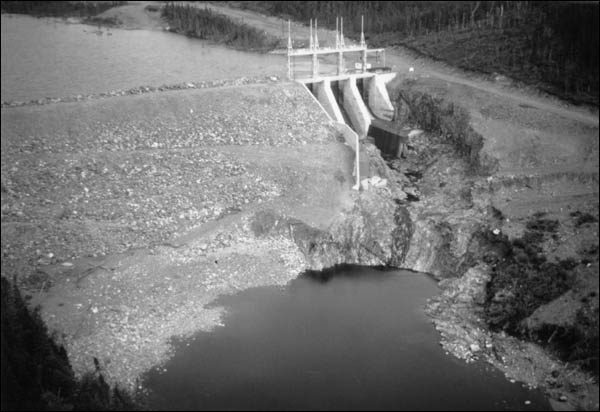Bay d'Espoir Hydro-Electric Project
One of the chief roadblocks to electrification was the fact that many people lived in small, remote, rural communities far from the main power generation centres. There was no province-wide power network. The existing electrical infrastructure was un-regulated, and voltage irregularities were common. This was a stumbling block for Premier Joseph Smallwood, who during the early 1950s had established a consortium of British interests to develop the province's natural resources (The British Newfoundland Company – BRINCO). In 1954 the provincial government established the Newfoundland Power Commission with a mandate to explore electricity generating options with a view to rural electrification. Smallwood wanted a major investment in hydro electrification, believing that cheap power would attract industry.

Surveys indicated the Bay d'Espoir area had the potential to generate large amounts of electric power. Located on the south coast of Newfoundland, Bay d'Espoir taps into a watershed with large lakes, and a significant river system, including the Salmon, Grey, and White Bear. The potential for using the Salmon and Grey Rivers for hydro-electric production was first recognized in the 1920s, when their power output was assessed at 160,000 hp. by the Nova Scotian promoter, Harry Crowe. An engineering study conducted in 1959 by a BRINCO subsidiary, the Southern Newfoundland Power and Development Company, showed that the Salmon River watershed had a potential of approximately 550,000 hp or about 400 mw compared to 5,000-plus mw at Churchill Falls in Labrador, and would cost $78 million to develop. BRINCO became more interested in developing the Hamilton (later renamed Churchill) Falls and shelved the Bay d'Espoir project.
Project Development
However, Smallwood was still interested in seeing power flow from Bay d'Espoir. The province purchased the Southern Newfoundland Power and Development Company's rights, assets, surveys, and all the preliminary engineering work for $500,000. BRINCO stayed on to assist with the project. To help pay for the development, the Newfoundland Power Commission received a $20 million grant from the Atlantic Development Board in 1964. The province raised an additional $40 million of the projected $90 million cost through the sale of bonds to the United States. The Bay d'Espoir electrification project took place in two stages.

Stage I
The engineering work began in April 1964 and the main construction work a year later. The first stage of the project employed 1,800 people totaling a $30 million payroll budget. The main camp site was named Camp Boggy and workers slept in bunkhouses and staff houses, and a mobile trailer camp was provided for 25 families in a town site. This living arrangement was typical of construction sites at the time.
The Bay d'Espoir hydro development plan was similar to the one at Churchill Falls. It did not involve a single large dam, but a system of smaller dams and dikes that enlarged the natural watershed and channeled water into a single channel. Specifically, the plan involved diverting the Salmon River to Northwest Brook . Grey River was also diverted into the Salmon and the river bed of Northwest Brook was deepened, with a generating station being built on the west side of the Northwest Brook.

The station used the flow of the Salmon River to power three 75 mw units, for a total of 225 mw. The target date for first power of Stage I was March 1, 1967, though this was delayed. Smallwood officially opened Stage I on August 15, 1967. The project went smoothly and on schedule for the most part, however there was some labour unrest in 1965 among non-unionized labourers, who demanded better wages and revised shift policies. Management acted swiftly to quell the unrest and on October 30th of that year an agreement was reached.
Aside from the hydro plant itself, the area benefited from the infrastructure that was built to facilitate the construction project. A new wharf and airport were built, as well as a road linking Bay d'Espoir to Bishop's Falls. Additionally, 520 miles of high-voltage transmission lines were built (running east to west) connecting St. John's, Bay d'Espoir, Grand Falls, Corner Brook, and Stephenville. This formed the backbone of the Bay d'Espoir network, allowing distribution of power and evening out loads across the province. It also played a key role in the rural electrification project.

Stage II
Stage 1 was projected to provide for the power needs of the province until at least 1978. However, rapid growth made it evident that more power would be necessary as early as 1969. This was due to the continued expansion of existing industry that had been impossible before Bay d'Espoir. There was also new industry being attracted to the province. This included the Electric Reduction Company of Canada, with a phosphorus plant at Long Harbour, Placentia Bay; a shipyard and fish plant at Marystown; a linerboard mill at Stephenville; and an oil refinery at Come By Chance.
In May 1966 the Commission decided to proceed with Stage II of Bay d'Espoir at a cost of $80 million. This required the diversion of the Victoria and White Bear rivers into the Salmon and Grey River watershed, as well as the construction of more power lines. Construction on Stage II began in the summer of 1966 and ended in April 1970. It brought three more generator units online, identical to the three established during Stage I. The total generating power of Bay d'Espoir was increased to 450 mw. The Bay d'Espoir hydroelectric project helped the Newfoundland government to integrate its approach to future power development. It also enabled Newfoundland Light and Power, which distributed electricity in the province, to offer uniform rates to urban and rural customers alike, and provided an incentive to attract new industry to the province. As of 1980, there were 80 full-time employees at the Bay d'Espoir hydro station, with an increased production output of 600 mw.




